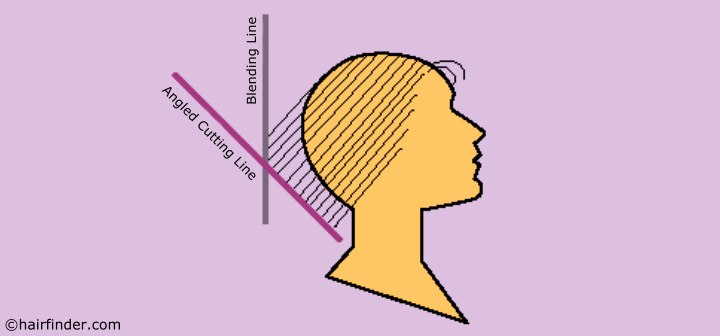

Higher standards of work, new stylists, pride in being a part of Francesco Group.ĭelegates will need: Scissors, Cutting Combs of varying lengths, Six Sectioning Clips, Hairdryer, a Denman or Vess Brush to wrap dry, Straightening Irons. See examples where the techniques are used, learn the techniques needed for creative work. Refining of skills and new knowledge to cut to the highest standard, removing the fear. An essential course for anyone who has achieved NVQ Level 2 and above, the Francesco Group ‘Classic Cutting’ course is also recommended for any stylist wishing to rejuvenate their technique and heighten their standards'.ĥ or 6 hair cutting techniques to be learned each day, using an in depth step-by-step watch and repeat learning method, along with visual examples of diagrams and imagery to demonstrate the techniques and potential results.
#Hair cutting angles diagrams professional#
Gamine also includes the pixie cut, which involves shorn sides and back with longer layers on top.Apprentices working towards their Advanced Creative Hair Professional (Level 3) Qualification and above. The literal French translation of 'gamine' is 'playful,' which is a fitting term to describe the "boyishly short and sassy hairstyle," says Penna, who points to Audrey Hepburn's iconic style as a prime example.

If texture is what you're looking for, consider a choppy look - a cut with short layers is typically for bobs or shoulder-length styles, says Penna. Blunt cuts, often known as bob cuts, are better suited for fine-haired ladies since they create the illusion of density and volume. The blunt cut is lopped at an angle of 0 degrees, making each strand fall at one length, Ross says.

RELATED: 1 Haircut, 6 Styles - The Pixie » With that, the ends are cut at multiple angles (versus a straight blunt edge) to boost volume and movement. This will determine the length of the shortest strands in front. With the head held vertically (straight up) choose your starting point. Comb the two halves of the hair forward over the shoulders. "The hair at the nape of the neck is cut the shortest, with layers radiating out as they reach the crown of the head," adds Penna. The first step is to comb the towel-dried hair until smooth and part the hair down the center of the head from the forehead to the nape of the neck. While a graduated cut requires a maximum angle of 90 degrees, a wedge haircut needs only 45, says Ross. "With this look, the layers stack closely on top of another, often adding a bit of needed bulk or weight to the style in specific areas," adds Penna. Thanks to this technique, there is more control for stylists to shape the desired outline of a cut. Another way to soften bluntness is to use "point cutting," a snipping technique that lops the ends at an angle to create a textured or feathered edge.Ī graduated cut involves layers, which for the hairstylist, means cutting at an angle of less than 90 degree. But in a long layered cut, the weight line is the longest layer." If you feel that your weight line is too heavy, Penna suggests asking your stylist to blend it in with thinning shears. "The weight line is at the end of the hair. Penna uses a blunt or bob cut as an example. Like the name implies, this is the area in a cut that holds the most weight. "For example, when a stylist wants to create a layered look, he will use a vertical cutting line." This is a line that stylists determine for a particular hairstyle, and its angle corresponds with how close or far apart the layers will look, says Penna. To thin with regular shears, also known as "slithering," stylists slide an open set of scissors along the shaft. By relying on thinning shears, the process creates super-fine layers and adds dimension, says Penna. Thinning is ideal for those with thick, dense tresses who want to eliminate bulkiness. Essentially, the end result is a ton of exaggerated layers. This is a cutting technique where hair is lifted and cut over the head to create extra body and volume, says Nick Penna Jr., owner and lead stylist of SalonCapri. Regardless of what terminology the stylist is using, Ross recommends always asking, "Will this technique create layers or remove them?" To avoid confusion and hair mishaps, double-check with your stylist. One-length cuts, on the other hand, add weight. Layers help lessen density and create movement. To help you communicate with your stylist and get the best cut ever, we've deciphered the most common salon jargon.Įvery cut falls under three categories: layered, one-length, or a combination of both, says celebrity hairstylist Dwayne Ross. Not knowing the language hairstylists speak can result in stressful trips to the salon, not to mention terrible haircuts.


 0 kommentar(er)
0 kommentar(er)
